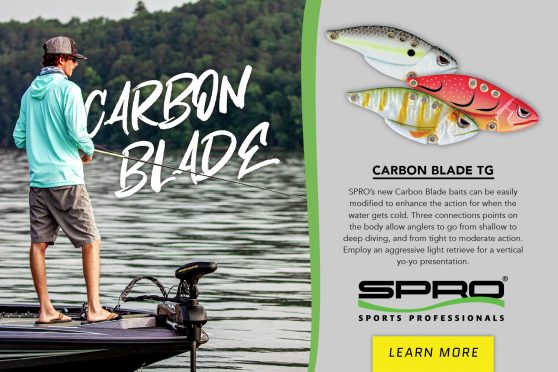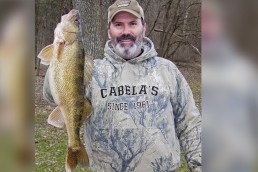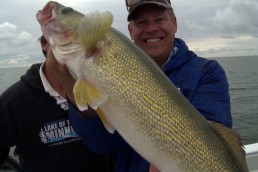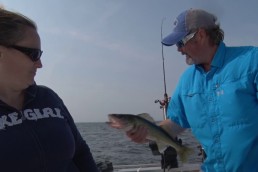Lake Winnebago Walleyes and How to Catch Them
SHARE THIS POST
 If its walleyes that you are after, then one of the Midwest’s premier lakes is sprawling Lake Winnebago, all 137,708 acres of it. If that doesn’t impress you, there are 85 miles of shoreline encompassing the cities of Fond Du Lac, Oshkosh, Appleton and Menasha. Green Bay is also a relatively a short drive north.
If its walleyes that you are after, then one of the Midwest’s premier lakes is sprawling Lake Winnebago, all 137,708 acres of it. If that doesn’t impress you, there are 85 miles of shoreline encompassing the cities of Fond Du Lac, Oshkosh, Appleton and Menasha. Green Bay is also a relatively a short drive north.
Lake Winnebago is the largest inland lake in Wisconsin. It is a drainage lake with the Fox River being the main inlet, entering on the lake’s west side. There are many smaller inlets including Buckstaff Creek, Pine Creek, Luco Creek, Johnson Creek and Mud Creek. The Fox River outlet is on the northwest side of Winnebago and continues its flow on into Green Bay. The average depth is only 15 feet and the deepest water is i in the mud flats in the lake’s center, where you can find water 20 feet deep.
There’s a rim of rock surrounding the lake to a depth of around 12 to 14 feet. The bottom of the lake has a layer of loose muck throughout the main basin. The lake’s west shore has a vast majority of Lake Winnebago’s structure; the points, the bays, the rock and gravel bars and reefs, and the vegetation, are all on the west side of Winnebago. The conservation group, Walleyes for Tomorrow, has created artificial reefs along much of the east side which help walleyes and saugers spawn in other places besides the marshes in the upper Wolf River and on rocks along the west shoreline.
These “new reefs” on the east side of Lake Winnebago are in the following places:
1) There’s a reef off Deadwood Point (the farthest reef south) about one-half to three quarters of a mile offshore, topping off at about 6 feet with 12 to 14 feet of water surrounding it. If you continue west past the first reef, there are two smaller reefs worth fishing.
2) Fisherman’s Road is the next area where an artificial reef is located. This reef is also about one-half mile off shore. This is a private landing, but worth the couple of bucks to launch sine it is a good landing and close to good walleye and perch fishing.
3) The town of Pipe has a nice park for camping at Winnebago Park. There are hook-ups and all the fishing and camping a family needs. There’s a good 4-hole landing and a little farther offshore (about a mile) another spawning reef.
4) The last of the reefs built on the east side is just outside Calumet Harbor and Columbia Park. This reef is only one-half mile offshore and tops off around 5 feet with 13 to 14 feet of water surrounding it. All of these reefs were built to add some spawning areas to the lake’s east side. Besides being for spawning, they hold fish on top when the wind blows, although fish are often there at other times.
The rest of the east side has little structure all the way north to High Cliff State Park, with the exception of the first breakline. Sometimes, though, baitfish school up on the mud flats off Stockbridge and Calumet County Park, where you should be able to mark fish on your electronics. If you see schools of baitfish anywhere on Lake Winnebago, fish the area because the walleyes will be close by.
Caution should always be used on Lake Winnebago because there are numerous unmarked reefs, and with the lake’s lack of depth, rough seas can pop up quickly.
Lake Winnebago is too shallow to have a thermocline. This means the lake has adequate oxygen levels throughout the water column all summer. The lake is very fertile. The water color can change from stained to blue/green by midsummer, when the algae bloom covers the lake. There’s not much as far as vegetation goes on the whole lake, with the exception of the west side bays like Asylum Bay and a few others.
As I said earlier, most of Winnebago’s structure is on the west shoreline. It is here that most of the lakes best structure is located. Heading north from Fond Du Lac, one of the first areas to fish is Kelly’s Point and Reef which is about 5 miles north. There are weeds around Kelly’s Point, so try pitching a jig and half a ‘crawler or a plastic twister tail into the weed openings for walleyes. There are also walleyes and perch off Kelly’s Point and Fraction Island. Try marking the reef with a marker and backtroll a ‘crawler and spinner rig off the edges for summer walleyes.
The next location to concentrate on is the most popular reef on the lake, Long Point Reef. His is a huge offshore reef that holds both walleyes and perch most of the year. As with all of Lake Winnebago’s reefs, wind is one of the key elements that you need to have success. When the wind blows on Lake Winnebago, head for the reefs, where casting crankbaits like Mann’s Stretch 5’s, Shad Raps, Wally Divers and ThunderSticks to the reef tops yields walleyes. Slip bobbers or floats tipped with a leech or half a nightcrawler also work well when cast to the top of the reef. Pieces of ‘crawlers or hellgrammites worked slowly along the bottom can produce perch up to 13 inches. Walleyes can also suspend in the deep water off Long Point Reef all summer long.
Are you enjoying this post?
You can be among the first to get the latest info on where to go, what to use and how to use it!
Heading north, Black Wolf Point has a weedy bay that contains largemouth bass and panfish. Walleyes can also be caught along the rocky shore and on the offshore reefs most of the year.
The 5- to 10-foot break from Paukotuk Reef south to Stretch Point is a good spot to troll deep-diving crankbaits. There are good weeds and riprap along the shoreline from Stoney Point south to Stretch Point. Try to cover as much of the area as possible, casting a jig and twister tail or half a ‘crawler tight to shore for walleyes.
Horseshoe Reef, Rasmussens Reef, and the 6- to 15-foot break at the entrance to Miller’s Bay contain good numbers of walleyes most of the year. Perch action is best during late summer, while walleyes bite best in the fall. Doemel Point and Miller’s Bay islands are walleye hot spots in the spring and early summer. The weeds in Miller’s Bay attract and hold pike, panfish and largemouth bass.
The deep water a couple of miles off the city of Oshkosh is usually loaded with all sizes of suspended walleyes. Use your electronics to locate walleye schools and their main forage, gizzard shad. This is a very good location, but it can be crowded.
The shallow rock bar east of Asylum Bay should be trolled with crankbaits like the ones mentioned earlier. The north side of the reef can be fished for perch with slip bobbers, small jigs and live bait. The perch in Winnebago bite best during the month of August.
East of Perkins Point about 3 miles there is a 16-foot rock hump that holds summer walleyes on it and the surrounding mud flat. Try the normal trolling pattern that I’ll discuss a little later.
Garlic Island has a group of reefs southeast of the island that produces walleyes and perch. Try trolling the trough between the reefs for success. The transition area where you go from rock to mud will hold fish, but it can be crowded. Blackbird Reef can also produce. This reef has a 10-foot drop where trolling spinner rigs works well. Nearby Little Blackbird Reef can also hold numbers of fish.
I’ve given you enough good fishing locations to last one’s lifetime! Now, I’ll give you some of the best methods for fishing Lake Winnebago waters.
It’s summer now, and most of the action revolves around open-water trolling. The majority of the fish have migrated to the main lake and now roam the deeper-water flats chasing shad, emerald shiners and young-of-the-year drum. They also feed heavily on bottom-dwelling red worms that hatch into lake flies, which the walleyes gorge on. The lake’s deepest water is in the middle of the lake, and with Winnebago being 30 miles long and 10 miles wide, there’s plenty of open water.
Troll these large areas with Daiwa line counter reels on long rods like the G. Loomis WTR 941, which at 7’10”, is long enough when used with the Off-Shore (OR12) planer boards to get your baits away from the boat, so that you aren’t spooking fish. I use 10- or 12-pound-test Stren mono and Crosslok snaps to secure the crankbaits. My favorite baits for trolling are Flicker Shads, ThunderSticks, Wally Divers, Mann’s Stretch 5s and Shad Raps in #5 and #7. One of my best colors has been anything with blue in it. Try fire tiger, black/chrome, blue/chrome, and purple if fishing is slow. Experiment with colors and check your baits regularly for weeds and small fish.
Spinners and ‘crawlers can also be deadly at times on Winnebago. The problem sometimes is that you catch too many drum and sheepshead, but sometimes they can be the ticket. Make sure to have an assortment of blades in all colors and sizes. If the wind blows, especially into the west shore, you can cast crankbaits and jigs right up to the rocky shore. Slip bobbers also can be part of your arsenal if the wind is blowing on the reef tops. But overall, trolling is the ticket day-in and day-out during July and August.
Lake Winnebago has numerous good-quality boat landings around the entire lake. The last few spawns have been good ones, so the future looks good.
MWO
SHARE THIS POST
Did you enjoy this post?
You can be among the first to get the latest info on where to go, what to use and how to use it!
Gary Engberg
If you have any questions or comments you may reach Gary Engberg at 608-795-4208 or garyengbergoutdoors.com.



